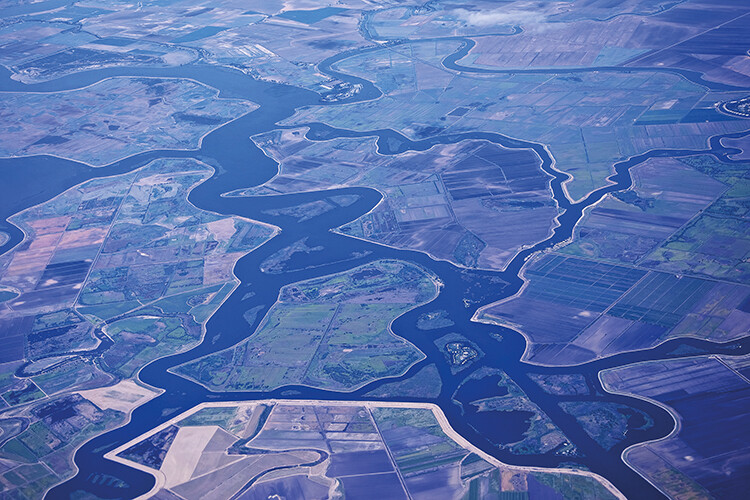

There are nearly 2,000 kilometres of levees in the Joaquin River delta in northern California. Image: Jeffrey T Kreulen/Shutterstock
Authorities had known that the ageing levee on the border of Monterey County, California, could fail. Built in the late 1940s, it provides flood protection for the agricultural town of Pajaro, home to some 3,500 residents – a ‘disadvantaged community’, one elected official would later tell the Los Angeles Times. In the early hours of 11 March 2023, as more than 30 centimetres of rainfall doused parts of the county, the Pajaro River breached the earthen embankment. The town was quickly submerged.
When US professor Farshid Vahedifard heard what had happened, he wasn’t surprised. Vahedifard, a specialist in resilient and equitable infrastructure at the United Nations University Institute for Water, Environment and Health (the UN’s ‘Think Tank on Water’), had been working on a new report on the communities living behind US levees. ‘I was not happy to see proof of what our paper was showing us,’ he says.
There are 6,825 levee systems across the USA, with a combined length of more than 39,000 kilometres – very nearly enough to encircle the globe.
More than 17 million US citizens are estimated to live in levee-protected areas but Vahedifard and his colleagues found that, nationwide, ethnic minorities and socially and economically disadvantaged populations are unequally exposed to the risk of levee failures. Vahedifard says that in Pajaro, where the per capita income is less than half the state and national average, the federal government had chosen not to take any action to reduce this risk. ‘Why? Because it wasn’t worth it. Because only poor communities live there.’
There are 6,825 levee systems across the USA, with a combined length of more than 39,000 kilometres – very nearly enough to encircle the globe. Most are in serious need of repair. At the time they were built – the average US levee is 59 years old, the oldest is 105 – there were no guidelines for their construction or maintenance. ‘These are not engineered structures with rigorous designs,’ says Vahedifard. ‘But over time, for reasons of urbanisation, land use change and climate change, the role of levees has changed. They now, unintentionally, play a critical role.’
In the last few decades, the USA has experienced a number of disasters triggered or exacerbated by levee failure. In 2005, when Hurricane Katrina struck the southeastern USA, floodwater quickly overwhelmed New Orleans’ inadequate levee system in more than 50 locations, leaving 80 per cent of the low-lying city underwater – by as much as three metres in some neighbourhoods. Vahedifard says the disaster that followed was a turning point that triggered […]
Full article: geographical.co.uk
Clean water is essential for life, yet millions of Americans unknowingly consume contaminants through their…
Human brains contain higher concentrations of microplastics than other organs, according to a new study, and the…
From the Office of the Governor: In anticipation of a multi-day, significant atmospheric river in Northern California,…
From Governor Newsom: Scientists, water managers, state leaders, and experts throughout the state are calling…
Photo: A harmful algal bloom in Milford Lake, Kansas, made the water appear bright green.…
An expanded plastic foam coffee cup is at a donut shop in Monterey Park, California.…